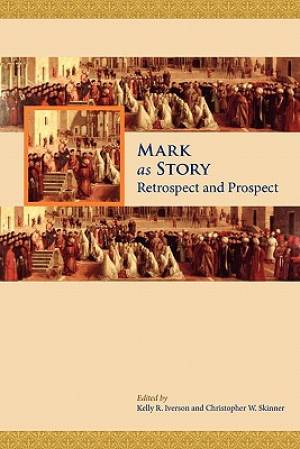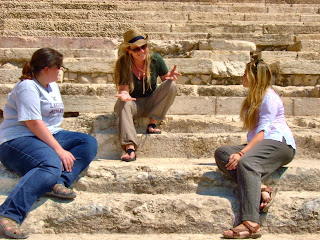Mark as Story: Retrospect and Prospect: An Interview with Christopher Skinner
Recently, I have developed a fascination for Mark’s Gospel and the field of narrative criticism. This interest, of course, has led me and countless others to the seminal work, Mark as Story, originally co-authored by David Rhoads and Donald Michie, and later joined by Joanna Dewey in subsequent editions. So influential has this work been that it has spawned another volume that is both based on and builds off this classic, entitled, Mark as Story: Retrospect and Prospect (SBL, 2011), co-edited by the tandem of Christopher W. Skinner, Assistant Professor of Religion at Mount Olive College in North Carolina, and Kelly R. Iverson, who will soon be a professor of New Testament at Baylor University. Adam Winn, another Markan scholar, gives the work high marks in a recent RBL review, and I found myself in agreement with his positive assessment. This work admirably carries the legacies of Rhoads, Michie, and Dewey’s book into the future of both narrative-critical and Markan scholarship. My friend, and one of the co-editors, Christopher Skinner, was nice enough to take the time and answer some questions I posed to him about this volume.
 |
| Christopher W. Skinner |
As we say in the book, Mark as Story, officially “broke the news” of narrative criticism
to the unsuspecting world of NT studies. The seeds of narrative criticism had
been germinating ever-so-slowly in the late 1970s, specifically among scholars
working with the Hebrew Bible. It wasn’t until the early 1980s that those
within NT studies expressed interest in reading the narrative in its final
form. This interest arose as redaction criticism was at its zenith in Gospel
studies. A certain segment of scholars grew weary of redaction critical method
and were looking for a less speculative and more honest and satisfying way of
approaching the text. Whereas redaction criticism had no
universally-agreed-upon starting point, narrative criticism did—you began with
the text in its final form. Thus, you were not only looking at the world behind
the text, you were being forced to examine the world within the text and,
eventually, the world(s) in front of the text. Narrative critics recognized the
value in source, form, and redaction criticisms but observed that an exclusive
focus on these methods had the unfortunate effect of breaking up the text so it
was never read in its entirety. The process of reading the text as a “whole
cloth” was something narrative critics were anxious to recover, and David
Rhoads was vocal about this in his scholarship.
 Mark
as Story (originally published in 1982), along with R. Alan
Culpepper’s Anatomy of the Fourth Gospel
(1983) laid the foundation for what narrative critics are doing today. Everything
began with those two works and, as it happens, David Rhoads and Alan Culpepper
had been doctoral students together at Duke and ran up very expensive long
distance telephone bills in the early 80s discussing these two projects with one
another.
Mark
as Story (originally published in 1982), along with R. Alan
Culpepper’s Anatomy of the Fourth Gospel
(1983) laid the foundation for what narrative critics are doing today. Everything
began with those two works and, as it happens, David Rhoads and Alan Culpepper
had been doctoral students together at Duke and ran up very expensive long
distance telephone bills in the early 80s discussing these two projects with one
another.
In answer to your question about the impact of Mark as Story on contemporary Markan
studies, let me briefly make three observations. First, the impact of Mark as Story can be observed by looking
at the bibliography of many books, monographs, and articles on the Gospel of
Mark published since the mid-1980s. It has proven to be a go-to resource, even
for those who aren’t working from a consciously narrative-critical approach. It
offers an elegant and insightful reading of the gospel and is not overly
technical. Second, another testament to the book’s enduring impact is the fact
that it’s still being used as a textbook in graduate, divinity, and doctoral
programs today. Originally published in 1982, the book was comprehensively
revised in 1999 (with the addition of Joanna Dewey as co-author), and a third
revised edition was released just a few months ago (largely as a result of our
project). Consequently, I was a seminarian in 1999 when I read the (revised)
book for the first time. I had not even seen the first edition prior to this
project. Third, as we’ve tried to point out in the book, a number of important
methodological trajectories have been spawned by the different iterations of narrative
criticism, several of which (e.g., reader-response criticism, performance
criticism) have proven to be of great interest to contemporary Markan scholars.
2. This
question flows naturally from the first. Could you describe the conversation
between yourself and Kelly Iverson that lead to this volume, Mark as Story: Retrospect and Prospect?
Kelly and I have been friends for the better part of 15
years. We met in seminary and we also ended up pursuing our doctoral studies at
the same institution. Our academic journeys have been similar and our thinking,
though often taking place independently of one another, has taken similar
trajectories. Both of us started out in Gospel studies approaching the text with
an overarching emphasis on history. I would say we have retained the very best
of our historical-critical training while using that as a springboard to shift
to narrative criticism and its related trajectories.
In 2008 we were sitting in our Boston hotel room at the
annual meeting of the Society of Biblical Literature discussing a session we
had both attended on the book, Anatomies of Narrative Criticism. The book was a 25-year celebration of Culpepper’s Anatomy of the Fourth Gospel, edited by
Tom Thatcher and Stephen Moore. We both felt strongly that something similar
should be done for Mark as Story, and
as I say in the introduction to the book, the project crystallized within a few
weeks. Everyone involved had an enthusiasm for the project that, quite frankly,
surprised us. As you know, academicians are not often given to effusive
displays of enthusiasm. With this project there was a great deal of enthusiasm
and excitement.
3. It’s
one thing to conceive such a volume and another to pull it off. This volume has
an impressive list of contributors. How were you able to get some of the
contributors that you did?
Honestly, it was not difficult to procure contributors
for this volume. We only had one scholar turn us down in the early stages and
even she expressed her regret at not being able to contribute because of heavy
administrative responsibilities. I think it’s a real testament to the impact of
Rhoads’, Michie’s, and Dewey’s work that such a strong list of contributors
would so eagerly sign on for this project. As I have already said, the
contributors were not just enthusiastic, they were anxious to participate. As
we note in the introduction, several contributors actually thanked us for
undertaking the project.
4. I
find the book to strike the right balance between essays on methodology and
essays that apply these methodologies to specific texts. Can you discuss the
importance of structuring the volume in this manner?
I can’t take credit for this one. The idea was Kelly’s.
From the start he thought it was essential to stress the importance of
narrative criticism for the development of a critical methodology as well as
its value for exegesis. Both of us had experienced these two truths in our own
development as scholars and we wanted to demonstrate the value of narrative
criticism for hermeneutics and textual interpretation. After we decided on this
basic structure we wanted to widen the circle to show how narrative criticism
“kicked the door open,” in a manner of speaking. We wanted to show how the rise
of narrative criticism within NT studies had helped pave the way for other
methods to see the light of day (including reader-response criticism,
performance criticism, postmodern criticism(s), postcolonial criticism, etc.). I
should also say that this book was a real labor of love for the both of us.
5. Your
essay, “Telling the Story: The Appearance and Impact of Mark as Story does a tremendous job of one, recounting the history
of Rhoads and Michie’s Mark as Story (and its subsequent
editions) and other works that have been inspired by that work, as well as
setting the tone for the remaining volume. Could you discuss the challenge of
writing such an essay for perhaps, the uninitiated reader?
First of all, thanks for the compliment. In many ways, my
contribution is the least substantive of any essay in the volume. It’s more
summative than anything. I wanted to faithfully ‘tell the story’ of the book
and what it helped establish in NT studies. Since we envisioned the book as a
text for both undergraduate and graduate students, we didn’t want the essays to
be too heavy. I really wanted to do two things—introduce narrative criticism
and examine how Mark as Story helped
get us there. As someone who feels indebted to the early narrative critics, it
was actually quite enjoyable to put the essay together. I felt a bit like a
journalist because after I wrote the more historical part of the essay, I had a
series of phone interviews with Rhoads, Michie, and Dewey where I attempted to
get a feel for the ethos of the guild in the early 1980s. (I was in elementary
school in the early 1980s!) Consequently, I feel that I have a much greater
appreciation for what went on and how it has impacted the field today.
6. Could
you express your hopes on how this volume might be used and the impact that it
might have in introducing readers to biblical narrative criticism?
Our original vision for the book was that it be used as a
textbook for courses on narrative criticism, NT hermeneutics, and the Gospel of
Mark. I am happy to see that book is already getting some attention in those different
venues. I know that it is being used as a course text in several institutions that
run courses on narrative criticism. I’m extremely happy about that. I also hope
the book will help initiate into the discipline those who have not previously
worked with narrative critical theory. For my part, I am interested in and
passionate about how historical criticism and narrative criticism can inform
and complement one another. I would love to see an ongoing dialogue between
those in historical-critical circles and those working with narrative,
reader-response, performance, and postmodern methodologies. I think our book
contributes to these dialogues and (hopefully) helps dispel the idea that
narrative criticism is ahistorical, unhistorical, or even anti-historical in
its basic orientation. This was a common complaint leveled against narrative
criticism by historical critics in the early days and it persists today. On
another note, I was pleased to hear from one of my former students this week.
He is pursuing doctoral work at the University of Edinburgh and he emailed to let
me know that the book is on permanent reserve at the university library. So, the book is getting some attention. I just
hope it helps advance some of the conversations Kelly and I are passionate
about.
Thanks for the interview and for giving our little book
some notice!

Comments